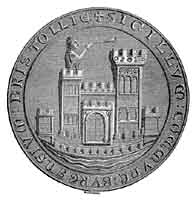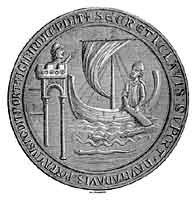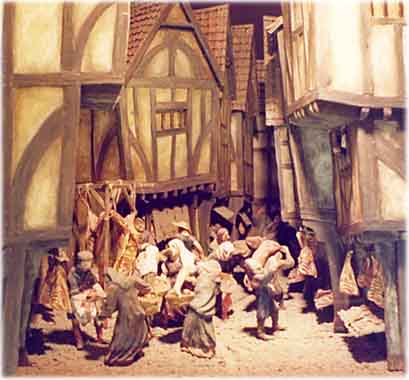 Introduction to the history of medieval
boroughs
Introduction to the history of medieval
boroughs Introduction to the history of medieval
boroughs
Introduction to the history of medieval
boroughs
|
Introduction menu Problems of definition | Continuity or creation? | Wiks, burhs, and ports Planned/planted towns | GROWTH OF SELF-GOVERNMENT | Urban economy | Urban society Sources of our knowledge | further reading |
| The growth of self-government |
Government consists of the institutions, means, and processes by which decisions are made, and made binding, and by which resources are consequently harnessed and applied, in a coordinated manner, for purposes of addressing the needs of and resolving the problems facing some community, great or small. Self-government comes about when, to facilitate achievement of such purposes, administrative authority and/or power is allocated, delegated, or arrogated to a community that exists within defined geographical limits. Towns – one type of institutionalized community within such limits – and town creation played a role in the efforts of English kings (and by imitation their greater subjects) to impose control over the country – a larger community – and to direct the activities of urban residents towards the larger purposes of establishing an administrative network and building national prosperity. The burhs and ports exemplify this and, earlier, after the Roman collapse some towns may have continued to serve as bases of administration for local rulers or Christian authorities – although this was more a continental than an English phenomenon. By the time of the Conquest, towns had been integrated into the national administrative structure; the Norman and succeeding dynasties did not re-invent so much as adapt this structure.
If urbanization was given shape on the one hand by the economic and political forces of the Anglo-Saxon period and on the other by established habits and values of collectivity and mutually supportive association, then the process was crystallized by grants of powers leading in the direction of a certain measure of governmental autonomy and self-determination. While we should not over-emphasize a separation between urban and rural society, it is hard to imagine that some sense of common interests and ambitions, different from those of country-dwellers but not necessarily exclusively economic, did not emerge during the period of physical and economic growth of the tenth to twelfth centuries; unfortunately, paucity of urban records from that period make this very difficult to demonstrate. What is better documented is the separation of town and country in terms of judicial and political forms.
It is reasonable to expect that social and legal traditions of Anglo-Saxon (and Scandinavian) England had to be adapted somewhat to an urban environment and circumstances. Anglo-Saxon society placed a great emphasis on association of its members, to provide mutual support and to answer for one another in a period when the effective power of the monarchy was limited. In a time without investigative policing, the guilt or innocence of a man accused of a crime might be determined by the number of kin, friends or neighbours who would vouch for or against him. The frankpledge system was an expression of this by ensuring that almost everyone was part of an association. Such elements found their way into the administration of legal customs and common law in towns, but were overlaid with other mechanisms of administration of justice stemming from the hundred system. In both cases the population density of urban areas necessitated some adaptation of the mechanisms.
The gild was another form of Anglo-Saxon association, which served individuals' social (including religious) needs and brought together individuals of similar interests, as well as being utilized by the legal system in a similar way to frankpledge. It was probably the fact of shared interests that directed some of the gilds towards common pursuit of economic improvement, which in turn gave rise to the impulse towards urban self-government. Just how common were these interest/lobby groups – later known as merchant gilds – is difficult to say. But it is not hard to believe that, in the period before self-government and urban ruling classes, at least those residents with the highest investment (regardless of whether commercial or landholding) in their towns would have sought, through associated influence and joint action, to direct the ambitions of the townspeople at large and to persuade superior authorities to delegate to their town powers that would protect and increase prosperity. At a later point gilds served as a vehicle for united expression of the interests of townsmen active in one or other of the local crafts; we do not need to seek Anglo-Saxon precedents to explain the appearance of craft gilds.
Nor must we, in discussing association, forget to mention briefly the folkmoot, not a purely urban form but a vehicle for broader community self-awareness, expression and decision-making, which however did not outlive its usefulness. Nonetheless, the principle of consulting the wider community on particularly weighty matters, through assemblies of citizens, remained in effect throughout the Middle Ages, even though there was a growing tendency – the product both of elitism and of bureaucratization – to control this through formalizing it within the constitution.
|
"Seal of the community of burgesses of Bristol " (inscription on left-hand view). |
||
 |
Imprints from 'common seals' were affixed to documents to indicate the town's official approval of a document's contents. As important instruments of borough government these seals were stored in locked chests and their use was often controlled within the constitution. |
 |
|
They bore images that symbolized urban characteristics considered significant by townspeople. In the case of Bristol, the town fortifications and a quayside are represented on the left-hand view, while on the reverse of the seal (right-hand view) we see a ship approaching the "secret quay" – though whether a fishing boat (as fish and eels swimming beneath it might imply) or a merchant ship is unclear; in either case it is the importance of a maritime-based economy which is being referred to. By the close of the Middle Ages it was recognized that such seals indicated the corporate nature of borough government. |
||
The desire for self-government seems to find a clamorous upsurge in the late eleventh and the twelfth centuries – not just in England, but across Europe – with varying results. The power of the monarchy in England, while an economic boon to towns, naturally restricted the scope of independence attainable. Nor should we automatically assume from continental examples that complete independence was even desired by English towns, apart perhaps from a few radicals. Although outbreaks of revolutionary indépendantisme of the London commune in the twelfth century (themselves prompted by power vacuums created during the civil war and Richard I's absence abroad) helped persuade kings to grant concessions, London was always precocious and had a strong sense of its own power in the realm; it may have been an inspiration, but cannot be considered a yardstick, for English urban history generally. For the most part, the king staved off any extreme efforts towards local autonomy through a gradual devolution of powers, countered by the development of a system of regional administrative controls into which the towns were slowly integrated.
It is in the context of legal and constitutional development that we use the term "borough" for towns. The early phases of debate regarding urban origins tended to focus on those aspects, notably issues such as the nature of the Anglo-Saxon burhgemot (was it a purely urban court?), whether there was a distinctive burhriht (i.e. set of legal customs applicable exclusively to towns) by the eleventh century, to what extent a non-feudal set of conditions governing landholding (burgage tenure) characterized towns, and the date and significance of early charter grants of liberties and the associated trend of towns acquiring control over the firma burgi. Anyone interested in these technical matters should read James Tait's important study. Unfortunately, waters are muddied by the fact that some places were credited with borough status even though they do not appear to have possessed features we might consider urban, while some market centres that seem urban did not acquire the legal attributes associated with "borough".
For brevity's sake, a series of general, but key, points will be listed here; readers may refer to the capsule histories of individual towns for case studies showing a few of the many variations that make it hard to generalize.
Henry I was the first king to lease the royal revenues to the towns from which they were due and to concede a handful of chartered privileges. London, not surprisingly, led the way. Its ambitions were imitated, although its gains not quite duplicated, by lesser towns (e.g. Oxford, Northampton, Winchester) which in turn became models for others. Under Henry II a large number of towns claimed to have received concessions from Henry I and, although charters proving this have not survived, Henry II was prepared to accept the claim and confirm the claimed privileges; but he was not prepared to let urban ambitions proceed to the point they had, often violently, in some parts of continental Europe. Under his sons, however, the leasing of borough farms and associated grants of powers including locally-elected officers multiplied, for Richard and John had not the strength of will of their father, and other preoccupations made them needy of the cash payments for such grants and the annual revenues they would bring.
Henry III and Edward I largely tried to maintain the status quo, by simply confirming the grants of their predecessors (the incentive being the financial "gifts" from towns seeking such renewals), although a few new privileges were extended, and – prompted by the civil wars – the monarchy encouraged towns to fortify themselves, by granting the right to collect special tolls to fund wall-building. At the same time, the king reasserted his dominance through temporary, punitive withdrawals of the chartered liberties, in the event of civil disobedience or lawlessness; it was always clear that urban self-government was obtained in the form of the grant of privileges from a higher authority, not as a recognition by such an authority of innate rights. The king also gave towns a voice – albeit a soft one – in national determination, through parliamentary representation; this helped make the towns aware that they were not islands, but part of a larger community.
Subsequent development of urban government focused largely on closer definition of the scope of jurisdiction of borough authorities and borough courts, on consolidation through the attainment of a formal corporate identity in the eyes of the law, and on the continued integration of the towns into the growing national system of judicial administration, (particularly through adding Commission of the Peace to the duties of the urban executive), regulation of trade, as well as the king's primary preoccupations with the maintenance of law and order and with national defence. The internal activities of town governments should not be ignored either, in terms of greater systematization of record-keeping, the expansion of bureaucracy with lesser officials responsible for a range of new activities and jurisdictions, and greater initiatives to develop new sources of revenue (such as property ownership) and more efficient mechanisms to manage the borough budget. By the close of the Middle Ages, municipal governments were engaged in much the same range of activities that they are today.
 |
|
Model depicting the York Shambles (butcher's
market), from the York Heritage Centre.
The butchers' market presented particular problems due to the human
health hazards involved in the slaughter of
animals and disposal of their entrails,
as well as risks from sale of spoiled
meat. |
Not all towns proceeded smoothly to a state of semi-autonomy. Towns of seigneurial foundation or those that became "mesne boroughs" when the king gave away his lordship to reward followers (a feature of the eleventh and early twelfth centuries) were often retarded in their development, compared to royal boroughs; Maldon provides an example. They might find themselves with an ongoing struggle on their hands over jurisdictional claims, with competing institutions of local government – those representing the town's lord and those representing its community. Again the best example from the small set of case studies here is Lynn; in the efforts of the local authorities in Lynn to undermine the jurisdiction of the borough lord, the Bishop of Norwich, it was not for nothing they sought the patronage of the king – although Bishop's Lynn succeeded in becoming King's Lynn only after it had passed its medieval peak.
 previous |
 main menu |
 next |
| Created: April 5, 1999. Last update: October 29, 2014 | © Stephen Alsford, 1999-2014 |